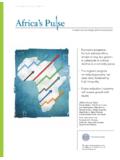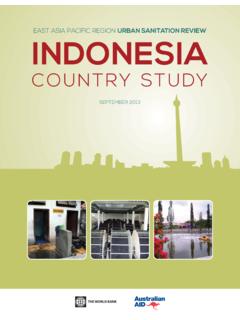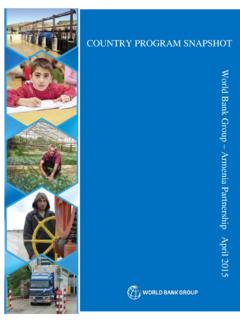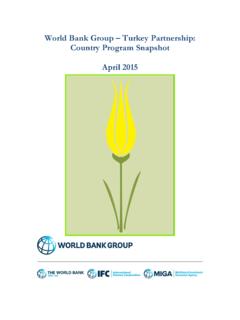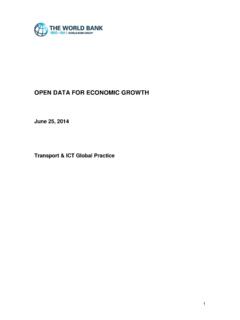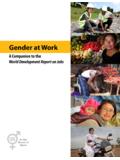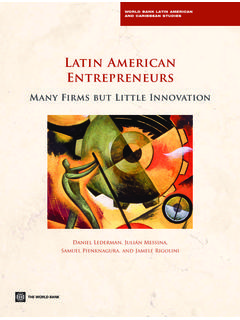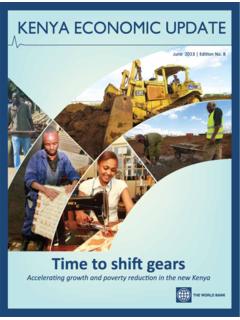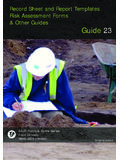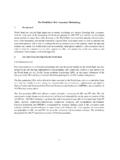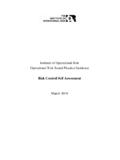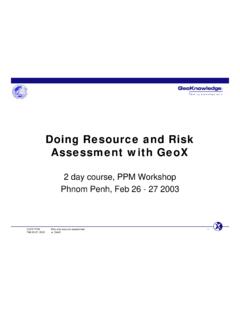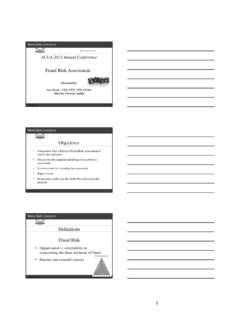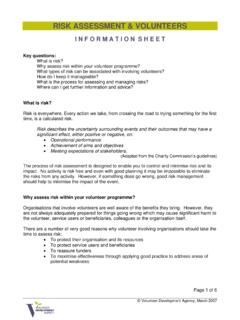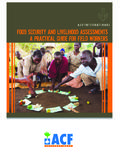Transcription of Interim Guidance Note Systematic Operations Risk-Rating ...
1 1 Interim Guidance Note Systematic Operations Risk-Rating tool (SORT) June 25, 20141 I. Introduction 1. The objective of the Systematic Operations Risk-Rating tool (SORT) is to help the world bank consistently assess and monitor risks across all operational instruments and country programs. This in turn will allow us to become more effective at supporting client countries in managing development results. The risks considered are the risks to development results associated with the operation: both the risks to not achieving the intended (positive) results intended by bank -supported Operations ; and the risks of bank -supported Operations causing unintended (negative) results. The SORT provides the information needed to help clients adequately manage and, where possible, mitigate operational risks within a broader risk management framework. It is intended to identify those risks on which the bank needs to focus management attention and resources within any given operation or at the level of the country, region, global practice or cross-cutting solution area.
2 2. The SORT will: (i) systematically and consistently rate risks of operational and country engagements in all regions and across all Operations (Investment Project Financing - IPF, Development Policy Financing DPF, and Programs for Results - PforR)2; (ii) help focus management attention on high and substantial risk Operations and on particular risks within Operations during implementation; and (iii) provide a light but Systematic and contestable way of identifying the appropriate level of corporate review process and any need for Board discussion. The SORT also applies to Country Partnership Frameworks (CPF), in order to focus management attention on high risk CPFs during preparation and implementation, to better link risk management at the country program level with risk management at the operational level, and to establish risk management as an integral part of country engagement.
3 The SORT covers risks during both the preparation and the implementation stages, in an integrated manner, and is updated throughout the life of the operation/CPF. 3. The SORT is harmonized across instruments and regions. It replaces the Operational Risk Assessment Framework (ORAF, for IPF Operations ) and the Integrated Risk Assessment Framework (for PforR Operations ), and will also apply to instruments that do not currently use a standardized risk assessment tool (DPFs and CPFs). The SORT will be the primary source of information for the so-called risk lists , inventories of the highest risk Operations that require special management attention at the regional or corporate level. 4. The SORT w ill be part of a broader framework for Operations risk management. The SORT itself is not intended to be a risk management strategy or mitigation plan. Instead, it is intended to be the screening mechanism on which such a plan would be based.
4 It would enable Management to focus attention on the highest risk Operations (and the highest risks within Operations ) during preparation and implementation. 1 Re-issued with minor updates on November 6, 2014. 2 The SORT will also apply to bank guarantees, which, beginning on July 1, 2014, are part of Development Policy Financing (in the case of policy-based guarantees) and Investment Project Financing (in the case of project-based guarantees). 2 This Guidance note is organized as follows: section II describes the SORT and its components. Section III provides an overview of the process of preparing and reviewing the SORT. Finally, section IV provides Guidance on how to rate risks in each category. II. The SORT 5. The SORT is a simple matrix consisting of nine risk categories, plus an overall risk assessment. The risks to be assessed in the SORT are defined as the client s risks to development results associated with the operation or operational engagement.
5 The risk assessment in the context of bank activities should therefore consider two types of risk: (i) risks to achieving the intended (positive) results as per the Program/Project Development Objectives (PDO) of the Operations , or the Country Partnership Objectives in the case of CPFs; and (ii) risks of adverse unintended (negative) consequences to the client flowing from the operational engagement, including risks to the money, people, and environment, even where these do not disrupt the achievement of the development objectives. In addition, the assessment takes into account both the likelihood of the risk materializing, as well as the severity of its impact on the achievement of the intended results. The risk assessment should be based on current residual risk, after taking into account the impact of mitigation measures that have already been implemented; but not presuming any future additional mitigation measures, beyond those already in place.
6 There is no pre-assigned weighting of the different aspects of risk under each category, and teams should use judgment in determining a single rating. Similarly, the overall risk rating does not necessarily reflect an average of the 9 individual ratings , but rather a judgment based assessment of the relative weight of risks under each category in the context of the CPF or operation. 6. It is important to emphasize that in all risk categories the assessment is of the risk to PDO or the risk of unintended consequences associated with the operational engagement, and does not refer to country level risk in and of itself. This means that for Operations , risk under each category should be assessed in the context of the specific project or program; or, in the case of programmatic DPF, in the context of the program series. For CPF, the risk assessment should be based on the proposed program of engagement.
7 As the assessed risks are specific to the operational engagement, ratings in each category may vary among different Operations in the same country. Risk Categories Rating (H, S, M or L) 1. Political and governance 2. Macroeconomic 3. Sector strategies and policies 4. Technical design of project or program 5. Institutional capacity for implementation and sustainability 6. Fiduciary 7. Environment and social 8. Stakeholders 9. Other Overall 3 7. In the SORT matrix, each risk category should be given a single rating, without additional comments or explanations (see paragraph 8 below for information on where to include this discussion). Staff should carefully consider the most important possible event under each category. If several different aspects are relevant in a given risk category, staff should use their own judgment to determine the single rating for that category, taking into account both the likelihood and the severity of the impact of each of the risks .
8 The four available ratings are high (H), substantial (S), moderate (M) and low (L). All risk categories should be rated, with the exception of other , which may be left blank if not applicable. 8. The SORT is a self-contained tool that is linked to the operation in the on-line portal3 and is also included in the project, program or CPF All ratings will be disclosed in the public documents related to the operation or CPF. In addition, the risk section of the Concept Note (CN), Project/Program Appraisal Document (PAD), Program Document (PD) or CPF Document states the overall risk rating and also discusses the most relevant risks . If the other risk category is selected, a brief description of the nature of the risks should also be included. In this section, teams are also required to summarize the client s plans and the bank s support for risk management and mitigation for the most relevant risks ; and update them in Implementation Status and Results Reports (ISRs) for Operations and Performance and Learning Reviews (PLRs) for CPFs.
9 III. Process 9. SORT will initially apply to all CPFs and CENs; and to all DPF and IPF Operations that are in the early stages of In the case of instruments that have passed the decision stage and/or are already under implementation, teams will not be required to retroactively change to the SORT. Instead, they will switch over and use the new template in the next Implementation Status and Results Report (ISR) or Performance and Learning Review (PLR). Preparing the template 10. The task team prepares a preliminary version of the SORT and write-up of the highest risks at the concept stage of the operation or CPF. The risk ratings will be part of the concept review package and will be discussed during the concept review meeting. The decision note will record the risk ratings agreed upon during the meeting, and these will be reflected in the next version of the SORT.
10 The ratings agreed on during the concept review will also help determine the processing track to be followed (in the case of IPF), and the level of corporate review required for the decision stage of the operation or CPF. 3 In the case of IPF, the SORT is part of the Operations portal during identification, preparation and implementation. In the case of PforR and DPF, the SORT is in the portal during implementation only (as part of the ISR). 4 See the revised templates for IPF, PforR, DPF and CPF for the exact location of the SORT. These templates are available on the OPCS website. 5 For more details on the transition arrangements, please refer to the kiosk announcement dated September 23, 2014. PforR Operations will begin applying SORT at a later date. 4 Updating the SORT 11. At the relevant decision points before negotiations, the SORT should be updated taking into account any additional information obtained during the preparation of the CPF or operation.

